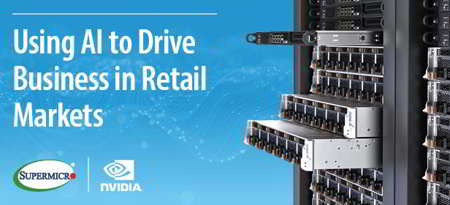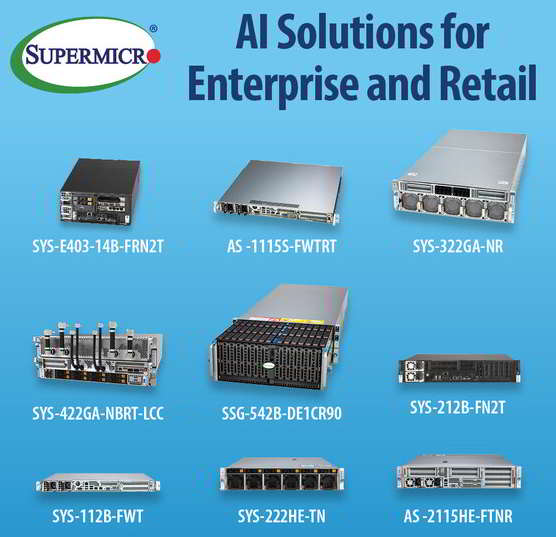NRF 2025: Supermicro Empowers AI-driven Capabilities for Enterprise, Retail, and Edge Server Solutions
Showcasing latest solutions in collaboration with Nvidia
This is a Press Release edited by StorageNewsletter.com on January 20, 2025 at 2:02 pmAt the National Retail Federation (NRF) annual show, Supermicro, Inc. is showcasing the latest solutions for the retail industry in collaboration with Nvidia Corp.
As GenAI grows in capability and becomes more easily accessible, retailers are leveraging Nvidia NIM microservices, part of the Nvidia AI Enterprise software platform, for a broad spectrum of applications.
“Supermicro’s innovative server, storage, and edge computing solutions improve retail operations, store security, and operational efficiency,” said Charles Liang, president and CEO, Supermicro. “At NRF, Supermicro is excited to introduce retailers to AI’s transformative potential and to revolutionize the customer’s experience. Our systems here will help resolve day-to-day concerns and elevate the overall buying experience.“
Innovation in front-of-house and back-of-house use cases – such as personalized shopping experiences, automating logistical processes, and preventing shrinkage – enable retailers to attract customers to their establishments and improve their profitability.
Supermicro at NRF
Retail AI solutions like the ones mentioned above require specialized hardware to deliver optimal results. Supermicro offers the industry’s broadest portfolio of edge AI solutions, giving retail organizations the tools to optimize the ROI of their AI-based applications. By processing data directly where the customers are located, results are delivered with minimal latency, creating an exceptional user experience. At NRF, the company is showing the latest systems designed to deliver high-end performance to retail locations:
- SYS-112B-FWT: This 1U, short-depth system offers edge compute, utilizing the latest Intel Xeon processors. Despite being less than 17″ in depth, it can hold Nvidia L40S GPUs.
- AS -1115S-FWTRT: Leveraging AMD’s EPYC series processors, this 1U, short-depth system offers customers flexibility in both core counts and GPU capability by having the capacity to hold a single double-width Nvidia L40S GPU.
- SYS-E403-14B: A compact server capable of delivering data center performance at remote and space-constrained locations. This compact system can accommodate 2 single-width or 1 double-width GPU cards, including the Nvidia L40S or Nvidia RTX 6000 Ada Generation GPU, in remote edge locations.
- SYS-212B-FN2T: The 2U, short-depth edge AI system offers more features and capacity compared to the competition and supports multiple data streams or workloads. Optimized for inferencing at the edge, the SYS-212B-FN2T supports up to 2 double-width GPU or single-width GPUs, such as the Nvidia L4 GPU.
- SYS-222HE-TN: A 2U powerhouse, this dual-processor system features the latest Xeon processors bringing data center power into a shorter-depth platform. With the ability to hold up to 3 Nvidia L40S GPUs, it brings serious inferencing power to the customer.
- AS -2115HE-FTNR: A uniprocessor, 2U system based on the latest AMD EPYC family. This system offers a maximum dual-width GPU density of 4 cards such as Nvidia L40S GPUs.
- SYS-322GA-NR: For the most demanding workloads, this powerful and versatile 3U edge AI platform offers 10 PCIe 5.0 x16 slots or 20 PCIe 5.0 x8 slots (in physical x16 slots). These slots can be fitted with up to 8 double-width GPU cards, such as Nvidia’s H100 GPU leveraging Nvidia NVLink. Alternatively, the system can be configured with 19 single-width GPU cards, such as Nvidia’s low-profile or single-width product families, or combined with different add-on cards, such as graphics controllers, making this system for environments including large control rooms.
An AI use case on display at the Supermicro booth is a customer service application built with the Nvidia AI Blueprint for digital humans. It features James, a computer interface that mimics the experience of interacting with a real person. Digital humans are virtual avatars that look, act, and think like a human would. In retail, this technology can be deployed to provide customers with a personalized shopping experience, a shopping assistant, and a customer service representative all in one solution.
A 2nd live demo is the Nvidia AI Blueprint for retail shopping assistants, a GenAI reference workflow designed to transform shopping experiences online and in stores. The blueprint provides the technologies for building shopping assistants that can search for multiple items simultaneously, answer contextual questions like whether a product is waterproof, and visualize furniture in physically accurate scenes, such as a customer’s living room.
A 3rd use case being demonstrated harnesses the Nvidia AI Blueprint for video search and summarization to combat the growing issue of shrinkage. Shrinkage occurs when products leave a store and are not paid for. Loss due to shrinkage costs retailers an estimated $100+B annually in the US alone. By using AI-based solutions, retailers can interpret camera input in real time and identify mix-ups at the checkout as they occur, providing direct feedback to the retail store and the customer.
















 Subscribe to our free daily newsletter
Subscribe to our free daily newsletter


